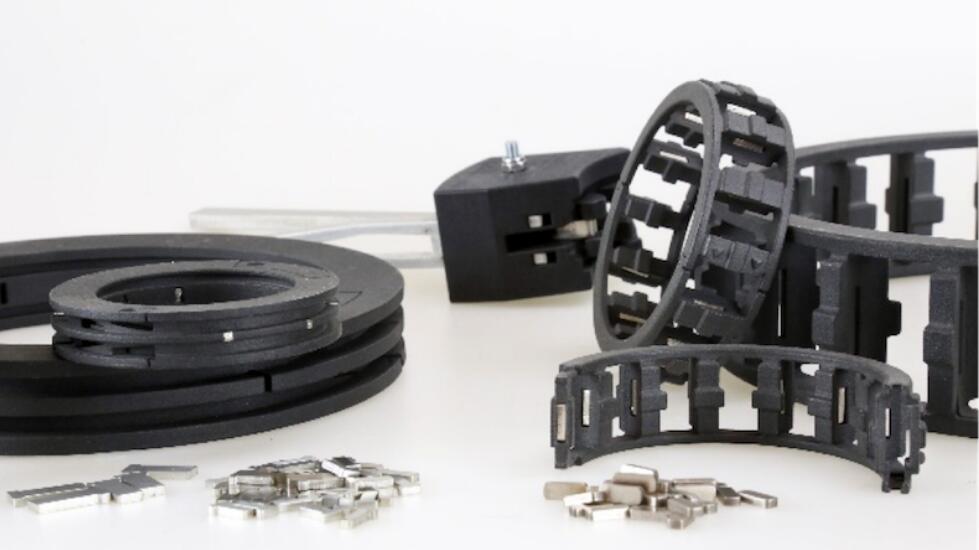Additive Manufacturing for Bearing Cages and Seals

Today, the bearing industry mostly adopts traditional manufacturing methods. For instance, bearing cages are normally stamped or machined if made of metal, either steel or brass, while the most common manufacturing method for polymer cages would be injection moulding with polyamide (nylon), acetal (delrin), polyetheretherketone (PEEK), phenolic resin, etc.
Today, bearing manufacturers use HP 3D Printing solutions as a game changing manufacturing method in the industry, especially regarding bearing cages and seals, by unlocking a cascade of benefits in terms of innovation, performance, durability and reliability of the bearing itself.
In terms of material properties, thanks to a reduction of friction and better elongation at break, as well as the possibility to obtain lighter pieces, the possibility to design complex geometries, to enable the bearing to support bigger loads, and finally, with cost savings due to elimination of additional tooling and equipment required to manufacture these components.
Bowman is a great example of how 3D printing can enable technology innovations in the industry. The British manufacturer designs, and 3D prints their patented seals, as well as resistant and durable bearing cages.
Bowman specifically chose the PA11 material, a bio-based nylon, for these applications, because of its resistance and mechanical properties. For instance, PA11 was proved to reduce friction and show better elongation at break, critical in assembly phases. This also led to lower levels of maintenance required and results in fewer spare parts needed. A great example on how choosing the right material and pairing it with the right additive manufacturing technology can help to improve part performance and ultimately, part life. Bowman’s addition of new split axial roller cages allowed for an axial load capacity of up to 10 times what was previously possible using traditional manufacturing. And they were able to increase radial load too, significantly enhancing bearing life overall.
So, from an improvement in part performance, consequentially came a longer part life.
Also, Bowman used to produce its seals for split roller bearings using aluminum, which sometimes resulted in damage to the steel housings and made assembly and disassembly an overall difficult process. Operating in environments where parts must be regularly maintained and downtime is at a premium, bearings significantly benefit from seals that can be assembled and reassembled easily and quickly.
Finally, traditional manufacturing for these parts used to require a lead time of 12 to 14 weeks, but using HP MJF technology resulted in a lead time reduction to only one week.
Bowman therefore invented a new patent-pending design for seals, which allowed them to modify other aspects of the bearing that surround the 3D printed components. And none of this would have been possible if it wasn’t for the design freedom and creativity HP Multi Jet Fusion allowed.
To conclude, it is commonly well known which are the most common reasons for bearing failure: big shocks, prolonged vibrations, lack of correct lubrication are some among them. At the same time, manufacturing bearings with traditional methodologies has its pain points: limitations in terms of creativity, with cages’ complex designs specifically, or even just several prototyping iterations to get to the perfect shape and size. Finally, in case of monitoring and maintenance, the need for additional seals for split bearings can easily delay operations.
And these areas are where additive manufacturing can come in handy:
Material properties: PA11 was proved to reduce friction and show better elongation at break, critical in assembly phases (with consequential lower levels of maintenance required and fewer spare parts needed).
Lighter components both for part consolidation and lighter raw materials (polymer vs traditional steel).
Endless design possibilities, for example for bearings with a very small diameter, or again for more complex shapes, with consequential increase of the load capacity of the cage of 30-40% as in the case of Bowman, and the possibility to do more R&D in terms of lubrication.
Finally, adoption of 3D Printing also includes potential huge savings in tooling, that can cost up to £60,000 for a set and would not be needed anymore, as in Bowman UK’s case.
And all of this will ultimately lead to bearings that live longer and have a better overall performance.
1.The news above mentioned with detailed source are from internet.We are trying our best to assure they are accurate ,timely and safe so as to let bearing users and sellers read more related info.However, it doesn't mean we agree with any point of view referred in above contents and we are not responsible for the authenticity. If you want to publish the news,please note the source and you will be legally responsible for the news published.
2.All news edited and translated by us are specially noted the source"CBCC".
3.For investors,please be cautious for all news.We don't bear any damage brought by late and inaccurate news.
4.If the news we published involves copyright of yours,just let us know.
Next Diagnosing Bearing Failures Using Ultrasound Spectrum Analysis
BRIEF INTRODUCTION
Cnbearing is the No.1 bearing inquiry system and information service in China, dedicated to helping all bearing users and sellers throughout the world.
Cnbearing is supported by China National Bearing Industry Association, whose operation online is charged by China Bearing Unisun Tech. Co., Ltd.
China Bearing Unisun Tech. Co., Ltd owns all the rights. Since 2000, over 3,000 companies have been registered and enjoyed the company' s complete skillful service, which ranking many aspects in bearing industry at home and abroad with the most authority practical devices in China.


